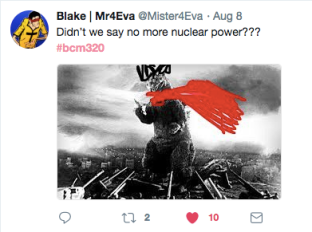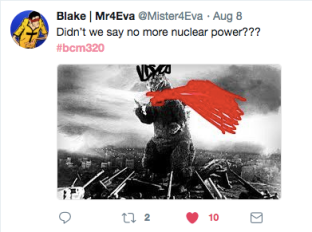This week in Digital Asia we got familiar with the research practice of autoethnography, which is an approach to research which looks for a way to use and examine personal experience in order to understand cultural experience. In the seminar we screened and live-tweeted the anime Akira (1988), and used this as an example to put this research practice into place.
A little background on Akira…it is a Japanese science fiction film directed by Katsuhiro Otomo and is set in a dystopian future (2019 which right now for us is only next year). [Wikipedia]. The instruction was to ‘put yourself in an experience of a culture that you are not familiar with’, this was by watching an anime movie called Akira, a culture that is different from my own. Also by live-tweeting, this also brings a unique experience of watching something and as a collective you can see and relate to other people’s reactions towards the film which I found super interesting as I observed.
Afterwards I went through the autoethnographic process:
- Determine your field site
My field site was the seminar classroom in which we were screening the film. It was also online on Twitter as we were all live-tweeting throughout.
2. Gather data
As I was watching the film I was trying to interpret what was going on but I was also reading how others were interpreting it. These are some screenshots of some people’s tweets.




Some people drew comparisons to the first film we watched of Gojira, with similar concepts within the stories. Others were comparing experiences of what we saw in the film to our own, an example being the many references to Toy Story and the rudeness of some of the male characters. There were also questions of authenticity in the anime experience watching it with American accents.
4. Interrogate your assumptions
I found that a lot of people watching this anime were confused, so I wasn’t alone in my thought process. The movie went for a full 2 hours so it was a long time to keep attentive while also trying to grasp what was happening which made it a little hard to keep up.
5. Engage in further research and analysis
The reading this week ‘Ellis et al’ (2011), gave a lot more insight into autoethnography. There was one part that read “the need to resist colonialist, research impulses of authoritatively entering a culture, exploiting cultural members and then recklessly leaving to write about the culture for professional gain, while disregarding relational ties to cultural members”.
I interpreted this as rather than looking at a culture from an outside perspective or exploiting cultural members, autoethnography comes into it by relating to another culture and looking at ourselves to then observe others. It strengthens our capacity to empathise with people who are different to us.
6. Communicate your findings
I did this through this blog post.

Reblogged this on Digital Asia.
LikeLike
When we look through the auto ethnographic process, it seems shorter reading it than actually acting it out. The main part of autoethnography is that we relate from personal experiences to relate to certain cultures. This is so we can create this bridge to different cultures and be more connected. I wouldn’t call the rudeness of the males apart of autoethnography, more so that was the character, especially Tetsuo, thats who he was.
I’m wondering what your personal interpretation of Akira was through tweets, I feel with autoethnography we can look at others, but we must also look at our own comments as we are the ones who truely experience and understand how we perceive foreign media.
I would love to see what you conclude from the film, as well as more in depth to why people perceived the film the way they did, the way to do that is to pinpoint the moments, not just what they say, but the reason. I suggest if you want, go back and view the film in subtitles as it gives the full experience. Good job on the post 🙂
LikeLiked by 1 person
Hey thanks for the reply! I’VE gotten some other feedback to give my own thoughts on the film, I guess I was so caught up in trying to make sense of autoethnography that I was looking for examples in other people. I found the film really long and the storyline was quite intricate. I think that is a good idea to watch the original with titles, and also a second time around watching I can make more sense of things!
LikeLiked by 1 person
Hey Tamara, I like how you’ve structured and clearly laid out and talked about each step of the autoethnographoc process.
I find it interesting that you’ve identified the “field site” as being the seminar classroom, and the Twitter live-feed. I thought that the field site was the thing that you were experiencing (Akira)? As in, this movie is my current autoethnographical field of research? Maybe I’m wrong about that though.
You’ve also mentioned how other people drew comparisons between Akira and other things they’ve seen, and that the film confused them, but feel like you haven’t really talked about YOUR views. How did you make sense of the film? What were the key epiphanies you had?
You’ve definitely engaged with the Ellis et al. reading, but I do think your individual viewpoint is missing a bit; which is a shame because I’d love to know what you thought!
LikeLiked by 1 person
Hi Elena, thanks for the reply! I read somewhere that the field site had to be carried out in the real world so I just identified with that but that is an interesting query I might follow up on. I had another response asking about my own take on the film so that is good feedback thank you, I guess I was so caught up on trying to make sense of autoethnography that I used other people as an example. The storyline was quite long and intricate for me so it was hard to follow, I think a second watch will be helpful and even in its original form with subtitles.
LikeLike